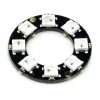MythMaker
Active Member
Hey everyone - making these "smartwatch" props for a cosplay of the Hunter from The Division game.
The Hunters have 6 - 9 of these smartwatches on their outfits as trophies that they have taken from agents they have taken down. If you look at the video (it should start at 1:03:48) you can see how some of the watches are dead, some are steady, but most of them are flickering.
https://youtu.be/Iajv_sHhgkU?t=1h3m48s

I made the watch to fit an LED strip inside, but now my question is, how do I get the LEDs to flicker? Is there some module I can wire in between the LED strip and the power source that will randomly flicker the lights? Similar to the lights you can get at Halloween that flicker intentionally? Thank you for any help!
~Matt Shields
The Hunters have 6 - 9 of these smartwatches on their outfits as trophies that they have taken from agents they have taken down. If you look at the video (it should start at 1:03:48) you can see how some of the watches are dead, some are steady, but most of them are flickering.
https://youtu.be/Iajv_sHhgkU?t=1h3m48s

I made the watch to fit an LED strip inside, but now my question is, how do I get the LEDs to flicker? Is there some module I can wire in between the LED strip and the power source that will randomly flicker the lights? Similar to the lights you can get at Halloween that flicker intentionally? Thank you for any help!
~Matt Shields

